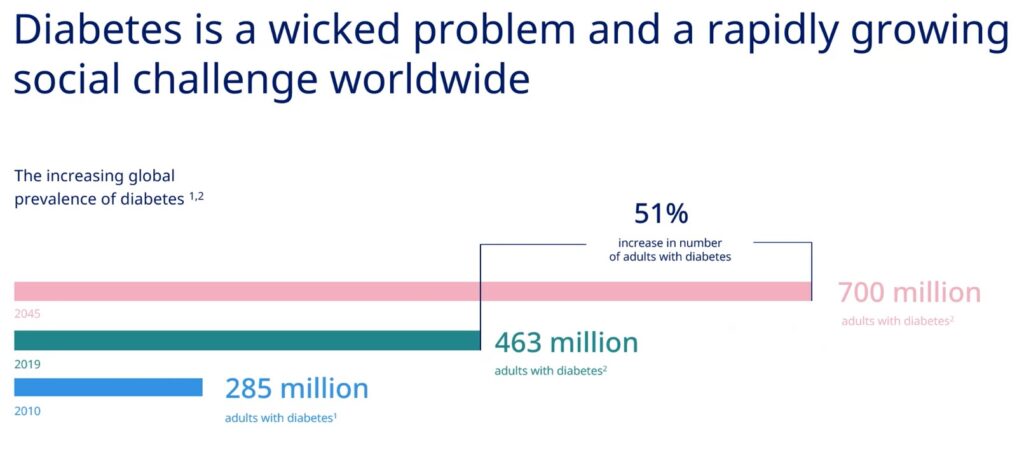Wicked Problems Need Wicked Solutions: Success Factors for Connected Drug Delivery

Presented by Matthew James Clemente, Former Corporate Vice President of Device Development at Novo Norodisk
Edited by Ben Norris
Clemente has since moved on to work at Bigfoot Biomedical.
Chronic diseases such as diabetes and obesity are a major challenge for healthcare providers. This is a trend that looks set to continue for the foreseeable future. In 2019, 74% of global deaths resulted from non-communicable diseases. For Matthew James Clemente, Former Vice President of Device Engineering at Novo Nordisk, the solution may lie within connected drug delivery.
Device Development for Confronting Non-Communicable Diseases
Novo Nordisk are the global market leaders in diabetes and pharmaceutical delivery, headquartered in Denmark. They supply nearly 50% of the world’s insulin, and in diabetes products alone they serve 30 million patients. As Matthew James Clemente explained to the audience at our 2021 Formulation & Delivery Europe: Online event, chronic diseases are seen as a major challenge to healthcare delivery. “Our purpose is to drive change to defeat diabetes and other serious chronic disorders such as obesity, rare blood and endocrine disorders.” To deliver on these goals, Clemente placed an emphasis on optimising digital ecosystems to provide tangible outcomes for patients, with a focus on what he termed as ‘wicked problems'.
"Our purpose is to drive change to defeat diabetes and other serious chronic disorders such as obesity."
In the context of healthcare delivery, wicked problems are challenges that have unforeseen outcomes that typically come with an additional degree of complexity, both in terms of issue behaviour and constraints on performance. “When we say wicked problems, we mean challenges that have unforeseen outcomes, a tremendous number of interdependencies, no clear solution, and typically come with a lot of complexity – both in terms of behavioural change and other social constructs or constraints.” One example of a wicked problem is chronic disease. “For us and for Nova Nordisk, chronic diseases are an urgent wicked global health challenge,” said Clemente. Four major non-communicable diseases (NCDs) drive the burden: diabetes, cardiovascular disease, chronic respiratory disease, and cancer. Together, these diseases account for an estimated 33 million deaths per year.
Wicked Problems for Drug Delivery
Diabetes is both a wicked problem and a rapidly growing challenge worldwide. In 2019, there were an estimated 463 million adults living with diabetes globally, up from 285 million in 2010. By 2045 that figure could be as high as 700 million – an increase of 51%. “The numbers have nearly doubled over the last decade,” Clemente summarised. Figures for obesity have followed a similar path, with cases often being tied into other health complications such as heart disease, type 2 diabetes, and certain types of cancers. An estimated 650 million adults live with obesity worldwide, as well as 120 million children – roughly equivalent to the entire population of Japan.

Additionally, 45% of people with obesity are not diagnosed, which may prevent them from seeking treatment. “There have been a lot of stigmas over obesity over the years,” continued Clemente, “and I think that as a society and in healthcare we are finally starting to debunk some of those myths.” Digital therapeutics may represent a means of providing a patient-centric process for treatment and healthcare. “We develop drugs in the industry we come from, but eventually those drugs need to get delivered – whether it’s through a tablet or through a device to the patient – where we’re hopefully impacting some metric or impacting some biological response that in some cases we can measure with a biomarker.”
Connected Drug Delivery: Implementation for Type 2 Diabetes
Having identified the scale of the challenges surrounding NCDs, how can they be confronted? According to Clemente, “wicked problems require wicked solutions.” He explained that it takes more than medicine and medicinal devices to drive change and defeat diabetes, identifying digital therapeutics as a means of tackling wicked problems. “Digital therapeutics are evidence-based therapeutic interventions that either prevent, manage or treat a medical disorder or disease.” They help to bridge the point between diagnostics and biomarkers, to prove that the delivery of therapy is equally as important as its implementation. “On a biological response and on a given pathway, how do we drive that efficiency?” To tackle NCDs, Clemente advocated for a focus on the outcomes before the technology. “Driving a truly patient-centric process sometimes means making drastic changes to data and timing requirements.”

He explained that placing a strong initial focus on solutions can diminish the innovation necessary to solve wicked problems, and advised researchers and clinicians to begin the process as a ‘solution agnostic’. “Placing outcomes at the top of the workflow hierarchy inherently changes the whole process – it’s critical that as you’re developing that infrastructure, you understand those needs for what they are.” Examples of this approach in diabetes therapy include maximising the patient’s value of medicines through personalised medication guidance, leading to better outcomes. “Easier initiation, improved titration of the molecule, fewer missed doses, and a longer stay time – all are levers to improving patient outcomes.”
- Overcoming Challenges in mRNA Manufacturing
- Discussion Group Report: Upscaling Lyophilisation Processes
- The Importance of Crystallisation Technology in API Particle Properties
Another focus of Clemente’s presentation was on providing digital solutions for personalised diabetes care to help people receive the maximum benefit from medicines. “There’s been tremendous growth over the last five or ten years with point of care solutions, with real-time data streaming from continuous glucose monitors, streaming from a number of diagnostic devices and partners.” Other approaches included bringing forward dose data from smart insulin pens which track how much insulin was taken and when, enabling dose guidance from digital therapeutics.
Future Provision of Healthcare Through Connected Drug Delivery
Combining healthcare data with real-world insights has already led to significant improvements in healthcare delivery and outcomes. The results from a small pilot carried out by Novo Nordisk in Sweden demonstrated a two-hour-per-day improvement in good glucose control, as well as 43% fewer missed mealtime injections. “It all comes down to patient experiences and solutions,” added Clemente. His summary of Novo Nordisk’s approach was that it aims to tackle wicked problems with a combination of systems thinking and agile methodologies. “Complex systems typically fail at their interfaces – more diverse internal and external competencies are needed to deliver in these areas. As much as you need good partners, you cannot outsource value-based trade-offs.”
Clemente rounded off by adding that within a pharmaceutical organisation, the traditional process is to follow a path of discovery through a scientific method of hypothesis and understanding. “We expand that space to find very unique and novel solutions that impact biology in a way we’ve never been able to do before.” He concluded that the solution to ensuring proper environment shaping across the organisation requires a proactive approach, as well as knowledge of different competencies, different mindsets, and different cultures. “You bring a solution all the way through that truly impacts on patient outcomes.”
To find out more about our Formulation series and to read other articles, visit our content portal. If you'd like to register your interest in our upcoming Formulation & Delivery US: In-Person event, click here.





